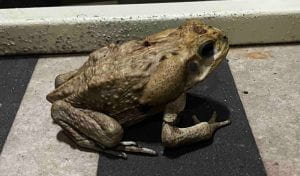Today sadly marked the end of our period at Glover’s, yet the start of our trip to Las Cuevas Research Station, an exciting new adventure. We started with a long (but immensely more comfortable) boat ride back to Belize City. This was the last encounter I will have with my taxon of stony corals, which construct the interconnected system of barrier-reefs that mirror the coastline of Belize. Once there we had a relaxing lunch in a waterfront restaurant, and then made our way to a general store/supermarket to buy snacks and the supplies I inevitably forgot or already consumed. We then made our way to the Tropical Education Center, which is associated with the Belize Zoo and is a quite cute center in the midst of the Belizean savanna.
Before dinner, we listened to a super interesting talk by Boris Arevalo, where he discussed the nesting ecology and habitat of Scarlet Macaws. We then ate dinner, after which, the real excitement took place. We went on a guided night tour of the Belize zoo! Our tour guide/zookeeper Carlos was extremely knowledgeable and affectionate towards the multitude of animals we saw such as; large cats, owls, white-lipped peccary, snakes, kinkajou, and more. I had lost hope though in encountering any amphibians today. I planned on writing about their relative shyness, and the possibility that their calls may be part of the cacophonous mix of noises which surrounds us. Yet, while approaching the last few feet before the zoo exit, a large toad sprung out of the darkness. I thought at first that it was a Southern Gulf Coast Toad, as they’re common and the coloration/body shape mostly matched the toad I saw tonight. The dry-looking bumpy skin, the ridging of the head, and the coloration all seemed to be correct for the most part (there will always be some sort of variation between individuals). However, after further research I am now thinking it was more likely a Cane Toad (Rhinella marinaI). The big giveaway are the large, balloon-like paratoid glands, which rest just behind the tympanum (ear drum). This little, or rather large hand-sized guy (the rough tan skin leads me to guess it’s a male) was a savior for my blog and field notebook and a good start for possibly encountering some elusive amphibians during this trip.

